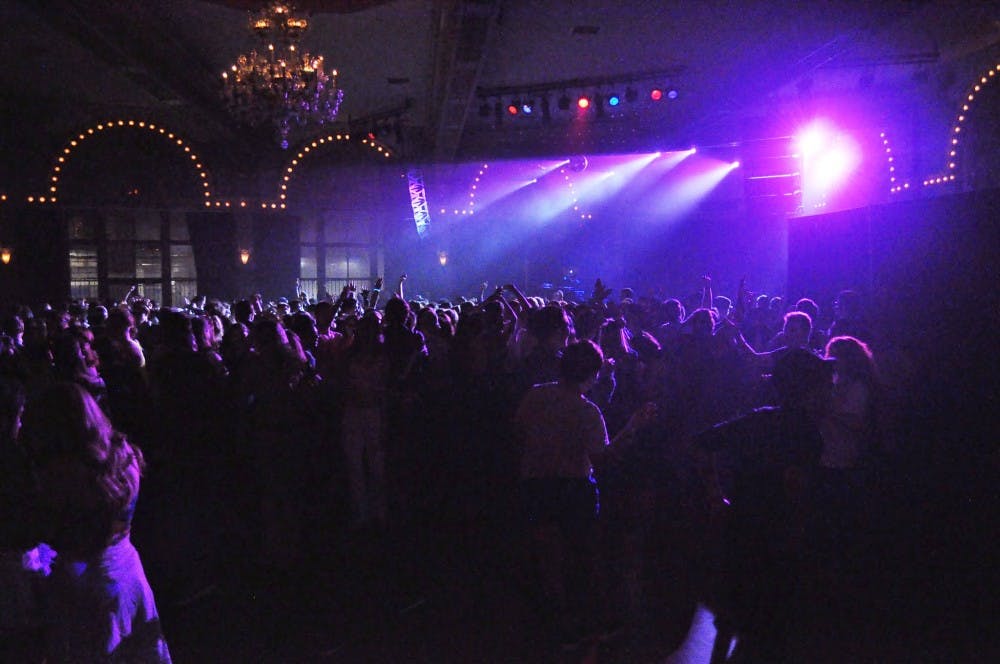Jacob Fuhrer |
More than 1,400 Pilots turned up for the annual Dance of the Decades at the Crystal Ballroom in downtown Portland Jan. 24.
For some, it was a night to remember. But for others, it’s a night they wish they could forget. In a college culture filled with pre-gaming and binge drinking, event organizers are left wondering what needs to be done to make the dance safer for everyone.
In all, a record-high 33 alcohol incidents were reported in which students were either too drunk to get on the bus to the venue, or not fit to enter the Ballroom. Three others were so seriously intoxicated that Portland Police escorted them individually from the dance to the Hooper Detoxification Center in North Portland.
Public Safety also confronted one student for possession of an unnamed narcotic.
Students drinking excessively and attending the dance is not a new problem, but it’s something Jeromy Koffler, director of Student Activities, wants to address.
Koffler met with representatives from Student Activities, the Campus Program Board, Residence Life and Public Safety to discuss ways they could have prevented some of the problems before and after the dance.
From that meeting, the team of representatives made five recommendations for future off-campus events:
- Catering options in The Cove or Buckley Center provided by CPB during the time that students are loading onto the buses, hoping that having some food in students’ stomachs will help ease the effects of the alcohol.
- Additional hall staff on-site during the loading process
- An event before the dance to prepare students for the evening ahead
- Tightened communication between staff at the ballroom and on campus
- A ride service to take intoxicated students to detoxification centers
“It’s not appropriate to have a quarter of Portland Police resources tied up with the dance,” Koffler said.
After an alcohol incident in 2011, student organizers suggested mandatory breathalyzer screening for all students before boarding the bus to the dance. The idea was met with resistance and ultimately never implemented, and according to the Gerry Gregg, Director of Public Safety, it’s going to stay that way.
“I don’t need a breathalyzer to tell me you are drunk,” Gregg said.
Gregg also stressed that despite the rumors, next year’s dance is not cancelled. No changes are planned, and though a number of people were confronted for alcohol use, that number represents just two percent of the dance attendees.
CPB Director Sarah Berger says although similar incidents several years ago led to UP being banned from the Red Lion and the Oregon Museum of Science and Industry, the Crystal Ballroom is not planning any action.
“We have a good relationship with the Crystal Ballroom,” Berger said, pointing out that a vast majority of students at the dance caused no problems. “We will be able to continue to use the space, as long as we continue to have good manners.”
Other colleges have also been cracking down on excessive alcohol use lately. In fact, to curb excessive drinking by students and improve campus safety, Dartmouth College announced a ban on hard liquor last week. Dartmouth’s president Philip Hanlon says the school is taking a stand against a problem that all colleges and universities face.
Research by the National Institute on Alcohol Abuse and Alcoholism shows four out of five college students drink, implying that many are underage drinkers who may be less experienced with alcohol.
This trend seems to hold true for attendees at the dance.
“My impression is the juniors and seniors were not causing many problems that night at all,” Koffler said. “A lot of the incidents we have are more freshman and sophomores.”
Koffler says some incoming students have an expectation of college as a time to party and drink excessively. He says students hear stories about others being drunk and want to experience it themselves.
“You don’t hear about the story where people were super responsible,” Koffler said.
Senior Jillian Stephens has seen freshmen at parties, and while she doesn’t want to place blame squarely on underclassman, she says they can be problematic.
“I’ve seen underclassmen full-force vomiting, and just incapacitated, and not in good shape,” Stephens said.
Stephens was at the Dance of the Decades, and while she chose to drink at the dance, it’s only because she is old enough to go to the bar. Stephens thinks the alcohol abuse is mostly an issue that comes from the drinking age that splits lower and upper classmen.
“At college you can really see that divide between people who know they can drink and those who know they can’t,” Stephens said.
To Public Safety, it’s all a matter of drinking responsibly and making smart decisions.
“You can’t take five straight shots thinking – oh that will give me a buzz that will last all night,” said Gregg. “That’s going to make you sick.”
Jacob Fuhrer is a reporter for The Beacon. He can be reached at fuhrer17@up.edu.








